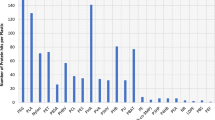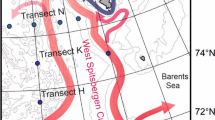Abstract
In the ever-expanding search for novel bioactive molecules and enzymes, marine actinomycetes have proven to be a productive source. While open reef sediment and sponge-associated actinomycetes have been extensively examined, their marine cave counterparts remain unevaluated. Anchialine cave systems in the Bahamas offered an ideal setting to evaluate the occurrence and variation within sediment-associated actinomycete communities. While in close geographical proximity to open reef environments, these systems provide a specialized environmental niche devoid of light and direct exposure to nutrient input. In the present study, selective isolation techniques and molecular methods were used to test the hypothesis that variable distribution of actinomycetes and secondary metabolite gene clusters occur between open reef and marine cave systems. The results indicated that differences exist within the culturable sediment-associated actinomycete communities between marine caves and open reef systems, with members of the genus Streptomyces dominating cultures from open reef sediments and a more diverse suite of actinomycetes isolated from marine cave sediment samples. Within the cave isolates, members of the proposed genus Solwaraspora were the most represented. Based on PKS- and NRPS-gene-targeted PCR amplification and sequencing, geographic variation in the occurrence of these biosynthetic pathways was also observed. These findings indicate that marine cave systems are a lucrative source in the search for novel secondary metabolite producers with biotechnological applications and that environmental and geographic factors likely affect the occurrence of these biosynthetic pathways.




Similar content being viewed by others
References
Airoldi L, Cinelli F (1996) Variability of fluxes of particulate material in a submarine cave with chemolithoautotrophic inputs of organic carbon. Mar Ecol Prog Ser 139:205–217
Altschul SF, Madden TL, Schaffer AA, Zhang J, Zhang Z, Miller W, Lipman DJ (1997) Gapped BLAST and PSI-BLAST: a new generation of protein database search programs. Nucleic Acids Res 25:3389–3402
Arisawa A, Matsufuji M, Nakashima T, Dobashi K, Isshiki K, Yoshioka T, Yamada S, Momose H, Taguchi S (2002) Streptomyces serine protease (DHP-A) as a new biocatalyst capable of forming chiral intermediates of 1,4-dihydropyridine calcium antagonists. Appl Environ Microbiol 68:2716–2725
Ayer SW, McInnes AG, Thibault P, Walter JA, Doull JL, Parnell T, Vining LC (1991) Jadomycin, a novel 8H-benz[b]oxazolo[3,2-f]phenanthridine antibiotic from Streptomyces venezuelae ISP5230. Tetrahedron Lett 32:6301–6304
Ayuso-Sacido A, Genilloud O (2005) New PCR primers for the screening of NRPS and PKS-I systems in actinomycetes: detection and distribution of these biosynthetic gene sequences in major taxonomic groups. Microb Ecol 49:10–24
Canganella F, Bianconi G, Kato C, Gonzalez J (2007) Microbial ecology of submerged marine caves and holes characterized by high levels of hydrogen sulphide. Rev Environ Sci Biotechnol 6:61–70
Challis GL, Hopwood DA (2003) Synergy and contingency as driving forces for the evolution of multiple secondary metabolite production by Streptomyces species. Proc Natl Acad Sci USA 100(Suppl 2):14555–14561
Chen H, Tseng CC, Hubbard BK, Walsh CT (2001) Glycopeptide antibiotic biosynthesis: enzymatic assembly of the dedicated amino acid monomer (S)-3,5-dihydroxyphenylglycine. Proc Natl Acad Sci USA 98:14901–14906
Das A, Khosla C (2009) Biosynthesis of aromatic polyketides in bacteria. Acc Chem Res 42:631–639
Engel AS, Porter ML, Stern LA, Quinlan S, Bennett PC (2004) Bacterial diversity and ecosystem function of filamentous microbial mats from aphotic (cave) sulfidic springs dominated by chemolithoautotrophic “Epsilonproteobacteria”. FEMS Microbiol Ecol 51:31–53
Eustaquio AS, Pojer F, Noel JP, Moore BS (2008) Discovery and characterization of a marine bacterial SAM-dependent chlorinase. Nat Chem Biol 4:69–74
Feling RH, Buchanan GO, Mincer TJ, Kauffman CA, Jensen PR, Fenical W (2003) Salinosporamide A: a highly cytotoxic proteasome inhibitor from a novel microbial source, a marine bacterium of the new genus Salinospora. Angew Chem 115:369–371
Fenical W, Jensen PR, Palladino MA, Lam KS, Lloyd GK, Potts BC (2009) Discovery and development of the anticancer agent salinosporamide A (NPI-0052). Bioorg Med Chem 17:2175–2180
Fichez R (1990) Decrease in allochthonous organic inputs in dark submarine caves, connection with lowering in benthic community richness. Hydrobiologia 207:61–69
Fichez R (1991a) Benthic oxygen uptake and carbon cycling under aphotic and resource-limiting conditions in a submarine cave. Mar Biol 110:137–143
Fichez R (1991b) Composition and fate of organic matter in submarine cave sediments; implications for the biogeochemical cycle of organic carbon. Oceanol Acta 14:369–377
Fiedler H-P, Bruntner C, Bull AT, Ward AC, Goodfellow M, Potterat O, Puder C, Mihm G (2005) Marine actinomycetes as a source of novel secondary metabolites. Antonie van Leeuwenhoek 87:37–42
Foldes M, Munro R, Sorrell TC, Shanker S, Toohey M (1983) In-vitro effects of vancomycin, rifampicin, and fusidic acid, alone and in combination, against methicillin-resistant Staphylococcus aureus. J Antimicrob Chemother 11:21–26
Gili JM, Riera T, Zabala M (1986) Physical and biological gradients in a submarine cave on the Western Mediterranean coast (north-east Spain). Mar Biol 90:291–297
Gontang EA, Fenical W, Jensen PR (2007) Phylogenetic diversity of gram-positive bacteria cultured from marine sediments. Appl Environ Microbiol 73:3272–3282
Gontang EA, Gaudencio SP, Fenical W, Jensen PR (2010) Sequence-based analysis of secondary-metabolite biosynthesis in marine Actinobacteria. Appl Environ Microbiol 76:2487–2499
Henkel T, Rohr J, Beale JM, Schwenen L (1990) Landomycins, new angucycline antibiotics from Streptomyces sp. I. Structural studies on landomycins A–D. J Antibiot (Tokyo) 43:492–503
Hill RT, Peraud O, Hamann MT and Kasanah N (2003) Manzamine-producing actinomycetes. United States of America Patent US 20050244938 A1
Humphreys WF (1999) Physico-chemical profile and energy fixation in Bundera Sinkhole, ananchialine remiped habitat in north-western Australia. J Roy Soc West Aust 82:89–98
Ichinose K, Bedford DJ, Tornus D, Bechthold A, Bibb MJ, Revill WP, Floss HG, Hopwood DA (1998) The granaticin biosynthetic gene cluster of Streptomyces violaceoruber Tü22: sequence analysis and expression in a heterologous host. Chem Biol 5:647–659
Jensen PR, Dwight R, Fenical W (1991) Distribution of actinomycetes in near-shore tropical marine sediments. Appl Environ Microbiol 57:1102–1108
Jensen PR, Williams PG, Oh D-C, Zeigler L, Fenical W (2007) Species-specific secondary metabolite production in marine actinomycetes of the genus Salinispora. Appl Environ Microbiol 73:1146–1152
Jiang S, Li X, Zhang L, Sun W, Dai S, Xie L, Liu Y, Lee K (2008) Culturable Actinobacteria isolated from marine sponge Iotrochota sp. Mar Biol 153:945–952
Kantola J, Kunnari T, Mantsala P, Ylihonko K (2003) Expanding the scope of aromatic polyketides by combinatorial biosynthesis. Comb Chem High Throughput Screen 6:501–512
Kim TK, Hewavitharana AK, Shaw PN, Fuerst JA (2006) Discovery of a new source of rifamycin antibiotics in marine sponge Actinobacteria by phylogenetic prediction. Appl Environ Microbiol 72:2118–2125
Lane DJ, Pace B, Olsen GJ, Stahl DA, Sogin ML, Pace NR (1985) Rapid determination of 16S ribosomal RNA sequences for phylogenetic analyses. Proc Natl Acad Sci USA 82:6955–6959
Magarvey NA, Keller JM, Bernan V, Dworkin M, Sherman DH (2004) Isolation and characterization of novel marine-derived actinomycete taxa rich in bioactive metabolites. Appl Environ Microbiol 70:7520–7529
Maldonado LA, Fenical W, Jensen PR, Kauffman CA, Mincer TJ, Ward AC, Bull AT, Goodfellow M (2005) Salinispora arenicola gen. nov., sp. nov. and Salinispora tropica sp. nov., obligate marine actinomycetes belonging to the family Micromonosporaceae. Int J Syst Evol Microbiol 55:1759–1766
Maldonado LA, Stach J, Ward A, Bull A, Goodfellow M (2008) Characterisation of micromonosporae from aquatic environments using molecular taxonomic methods. Antonie Van Leeuwenhoek 94:289–298
Maldonado LA, Fragoso-Yáñez D, Pérez-García A, Rosellón-Druker J, Quintana E (2009) Actinobacterial diversity from marine sediments collected in Mexico. Antonie van Leeuwenhoek 95:111–120
Mayer AMS, Glaser KB, Cuevas C, Jacobs RS, Kem W, Little RD, McIntosh JM, Newman DJ, Potts BC, Shuster DE (2010) The odyssey of marine pharmaceuticals: a current pipeline perspective. Trends Pharmacol Sci 31:255–265
McLeod MP, Warren RL, Hsiao WW, Araki N, Myhre M, Fernandes C, Miyazawa D, Wong W, Lillquist AL, Wang D, Dosanjh M, Hara H, Petrescu A, Morin RD, Yang G, Stott JM, Schein JE, Shin H, Smailus D, Siddiqui AS, Marra MA, Jones SJ, Holt R, Brinkman FS, Miyauchi K, Fukuda M, Davies JE, Mohn WW, Eltis LD (2006) The complete genome of Rhodococcus sp. RHA1 provides insights into a catabolic powerhouse. Proc Natl Acad Sci USA 103:15582–15587
Metsä-Ketelä M, Salo V, Halo L, Hautala A, Hakala J, Mäntsälä P, Ylihonko K (1999) An efficient approach for screening minimal PKS genes from Streptomyces. FEMS Microbiol Lett 180:1–6
Metsä-Ketelä M, Halo L, Munukka E, Hakala J, Mäntsälä P, Ylihonko K (2002) Molecular evolution of aromatic polyketides and comparative sequence analysis of polyketide ketosynthase and 16S ribosomal DNA genes from various Streptomyces species. Appl Environ Microbiol 68:4472–4479
Miller ED, Kauffman CA, Jensen PR, Fenical W (2006) Piperazimycins: cytotoxic hexadepsipeptides from a marine-derived bacterium of the genus Streptomyces. J Org Chem 72:323–330
Mincer TJ, Jensen PR, Kauffman CA, Fenical W (2002) Widespread and persistent populations of a major new marine actinomycete taxon in ocean sediments. Appl Environ Microbiol 68:5005–5011
Pfeifer V, Nicholson GJ, Ries J, Recktenwald J, Schefer AB, Shawky RM, Schroder J, Wohlleben W, Pelzer S (2001) A polyketide synthase in glycopeptide biosynthesis: the biosynthesis of the non-proteinogenic amino acid (S)-3,5-dihydroxyphenylglycine. J Biol Chem 276:38370–38377
Piecq M, Dehottay P, Biot A, Dusart J (1994) Cloning and nucleotide sequence of a region of the Kibdelosporangium aridum genome homologous to polyketide biosynthetic genes. DNA Seq 4:219–229
Pohlman J, Iliffe T, Cifuentes L (1997) A stable isotope study of organic cycling and the ecology of an anchialine cave ecosystem. Mar Ecol Prog Ser 155:17–27
Prudhomme J, McDaniel E, Ponts N, Bertani S, Fenical W, Jensen P, Le Roch K (2008) Marine actinomycetes: a new source of compounds against the human malaria parasite. PLoS One 3:e2335
Ramesh S, Mathivanan N (2009) Screening of marine actinomycetes isolated from the Bay of Bengal, India for antimicrobial activity and industrial enzymes. World J Microb Biot 25:2103–2111
Sarabia F, Chammaa S, Ruiz AS, Ortiz LM, Herrera FJL (2004) Chemistry and biology of cyclic depsipeptides of medicinal and biological interest. Curr Med Chem 11:1309–1332
Sarbu SM, Kane TC, Kinkle BK (1996) A chemoautotrophically based cave ecosystem. Science 272:1953–1955
Schoemaker HE, Mink D, Wubbolts MG (2003) Dispelling the myths—biocatalysis in industrial synthesis. Science 299:1694–1697
Seymour JR, Humphreys WF, Mitchell JG (2007) Stratification of the microbial community inhabiting an anchialine sinkhole. Aquat Microb Ecol 50:11–24
Shen B (2003) Polyketide biosynthesis beyond the type I, II and III polyketide synthase paradigms. Curr Opin Chem Biol 7:285–295
Sket B (1996) The ecology of anchihaline caves. Trends Ecol Evol 11:221–225
Slattery M, Gochfeld DJ, Iliffe TM, Kakuk B, Kelly M (2002) Biodiversity and competitive interactions of cave sponges in the Bahamas. Boll Musei Ist Biolog 66:184
Smith JL, Sherman DH (2008) An enzyme assembly line. Science 321:1304–1305
Swofford DL (2003) Phylogenetic analysis using parsimony (*and other methods), version 4. Sinauer Associates, Sunderland, MA
Walsh CT (2004) Polyketide and nonribosomal peptide antibiotics: modularity and versatility. Science 303:1805–1810
Walsh CT (2008) The chemical versatility of natural-product assembly lines. Acc Chem Res 41:4–10
Weyland H (1981) Distribution of actinomycetes on the sea floor. Zentralbl Bakteriol Suppl 11:185–193
Wright LF, Hopwood DA (1976) Actinorhodin is a chromosomally-determined antibiotic in Streptomyces coelicolor A3(2). J Gen Microbiol 96:289–297
Zhang C, Kim S-K (2010) Research and application of marine microbial enzymes: status and prospects. Mar Drugs 8:1920–1934
Acknowledgements
We thank the staff of the Caribbean Marine Research Center (CMRC) for housing, facilities, and assistance with sample collection. We also thank D. Gochfeld for assistance in sample collection and C. Easson for assistance with figures. This project was supported by NOAA/NIUST National Institute for Undersea Science and Technology grant NA16RU1496 to J.B.O.
Author information
Authors and Affiliations
Corresponding author
Rights and permissions
About this article
Cite this article
Hodges, T.W., Slattery, M. & Olson, J.B. Unique Actinomycetes from Marine Caves and Coral Reef Sediments Provide Novel PKS and NRPS Biosynthetic Gene Clusters. Mar Biotechnol 14, 270–280 (2012). https://doi.org/10.1007/s10126-011-9410-7
Received:
Accepted:
Published:
Issue Date:
DOI: https://doi.org/10.1007/s10126-011-9410-7




